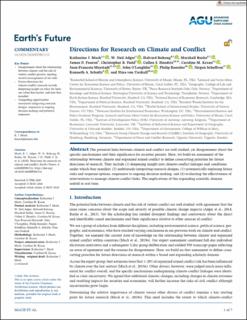| dc.contributor.author | Mach, Katharine J. | |
| dc.contributor.author | Adger, W. Neil | |
| dc.contributor.author | Buhaug, Halvard | |
| dc.contributor.author | Burke, Marshall | |
| dc.contributor.author | Fearon, James D. | |
| dc.contributor.author | Field, Christopher B. | |
| dc.contributor.author | Henrdrix, Cullen S. | |
| dc.contributor.author | Kraan, Caroline M. | |
| dc.contributor.author | Maystadt, Jean-Francois | |
| dc.contributor.author | O'Loughlin, John | |
| dc.contributor.author | Roessler, Phillip | |
| dc.contributor.author | Scheffran, Jürgen | |
| dc.contributor.author | Schultz, Kenneth A. | |
| dc.contributor.author | von Uexkull, Nina | |
| dc.date.accessioned | 2022-12-13T08:27:01Z | |
| dc.date.available | 2022-12-13T08:27:01Z | |
| dc.date.created | 2021-02-15T12:05:27Z | |
| dc.date.issued | 2020 | |
| dc.identifier.issn | 2328-4277 | |
| dc.identifier.uri | https://hdl.handle.net/11250/3037380 | |
| dc.description.abstract | The potential links between climate and conflict are well studied, yet disagreement about the specific mechanisms and their significance for societies persists. Here, we build on assessment of the relationship between climate and organized armed conflict to define crosscutting priorities for future directions of research. They include (1) deepening insight into climate–conflict linkages and conditions under which they manifest, (2) ambitiously integrating research designs, (3) systematically exploring future risks and response options, responsive to ongoing decision‐making, and (4) evaluating the effectiveness of interventions to manage climate–conflict links. The implications of this expanding scientific domain unfold in real time. | en_US |
| dc.description.abstract | Directions for Research on Climate and Conflict | en_US |
| dc.description.abstract | The potential links between climate and conflict are well studied, yet disagreement about the specific mechanisms and their significance for societies persists. Here, we build on assessment of the relationship between climate and organized armed conflict to define crosscutting priorities for future directions of research. They include (1) deepening insight into climate-conflict linkages and conditions under which they manifest, (2) ambitiously integrating research designs, (3) systematically exploring future risks and response options, responsive to ongoing decision-making, and (4) evaluating the effectiveness of interventions to manage climate-conflict links. The implications of this expanding scientific domain unfold in real time. | en_US |
| dc.language.iso | eng | en_US |
| dc.publisher | Wiley Open Access | en_US |
| dc.relation.uri | https://agupubs.onlinelibrary.wiley.com/doi/full/10.1029/2020EF001532 | |
| dc.rights | Navngivelse 4.0 Internasjonal | * |
| dc.rights.uri | http://creativecommons.org/licenses/by/4.0/deed.no | * |
| dc.title | Directions for Research on Climate and Conflict | en_US |
| dc.title.alternative | Directions for Research on Climate and Conflict | en_US |
| dc.type | Peer reviewed | en_US |
| dc.type | Journal article | en_US |
| dc.description.version | publishedVersion | en_US |
| dc.source.volume | 8 | en_US |
| dc.source.journal | Earth's Future | en_US |
| dc.source.issue | 7 | en_US |
| dc.identifier.doi | 10.1029/2020EF001532 | |
| dc.identifier.cristin | 1889831 | |
| dc.relation.project | EC/H2020/648291 | en_US |
| cristin.ispublished | true | |
| cristin.fulltext | original | |
| cristin.qualitycode | 1 | |

